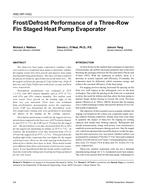Description
Two three-row heat pump evaporators (outdoor coils) were tested on a residential heat pump to determine whether fin staging would slow frost growth and improve heat pump frosting/defrosting performance. The base coil had a uniform fin density of 20 fins/in.(fpi)(8 fins/cm)on the three rows. The fin staged coil had a fin spacing of 15 fpi (6 fins/cm),20 fpi (8 fins/cm),and 25 fpi (10 fins/cm) on the front, second, and back rows, respectively.
Frost/defrost performance was evaluated at 28°F (–2.2°C)with 90% relative humidity and at 35 °F (1.7°C) with 82% and 95% relative humidity. Two airflow rates were tested. Frost growth on the leading edge of the front row was measured. Frost mass was estimated from psychrometric easurements across the evaporator. Cyclic COP was determined for the frost/defrost cycle. Two steady-state cooling tests were performed to determine the impact of fin staging on the cooling capacity.
Frost/defrost performance results for the staged coil were mixed when compared to the base case.At 95% relative humidity and 35°F (1.7°C), the COP was 8.7% lower for the staged coil. The frost/defrost cycle time decreased from 6% to 30% for the staged coil, depending on airflow, at 35°F (1.7°C). In contrast, the frost/defrost cycle time increased from 21% to 23% for the staged coil at 28°F (–2.2°C). Frost growth on the leading edge of the evaporator fins was higher for the staged coil in most cases. However, the wider spacing on the front row allowed for a thicker frost layer to form. These mixed results were different fro those of previously tested two-row evaporators. It was hypothesized that the mixed results could have been the result of the refrigerant circuiting not being optimized for the coils tested.
Units: Dual
Citation: ASHRAE Transactions, vol. 108, pt. 2
Product Details
- Published:
- 2002
- Number of Pages:
- 12
- File Size:
- 1 file , 750 KB
- Product Code(s):
- D-8953




